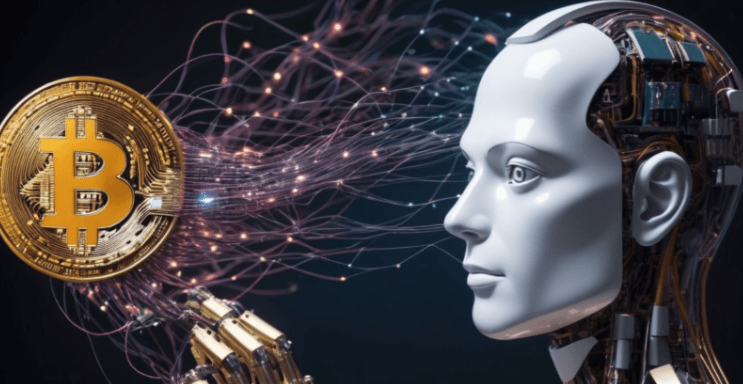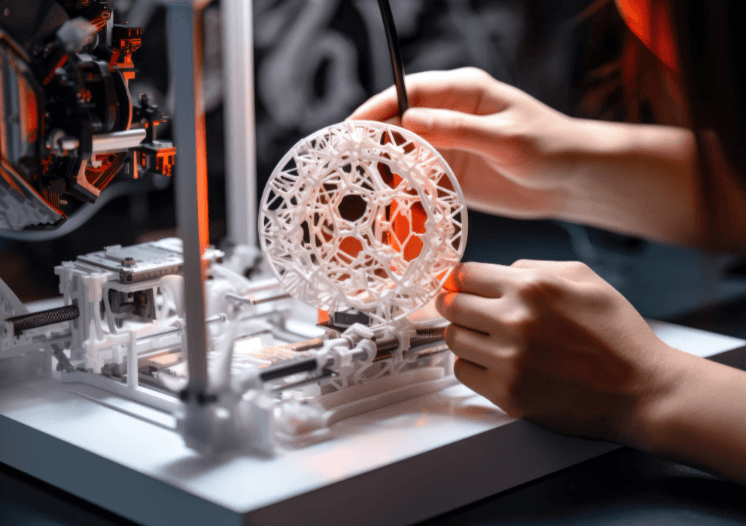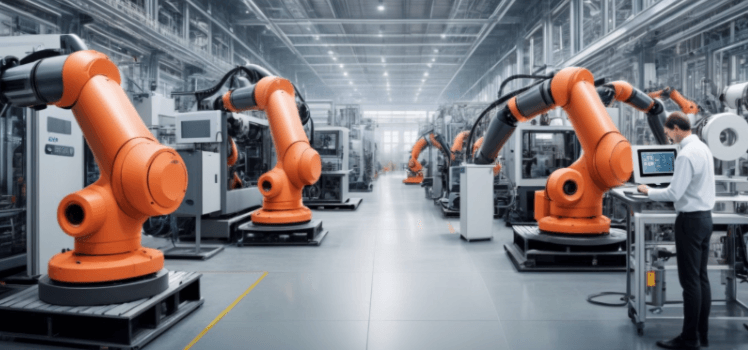Blockchain Beyond Cryptocurrency: Its Impact on Industry 4.0
The article explores the integration of blockchain technology with the driving forces of Industry 4.0, including the Internet of Things (IoT), Artificial Intelligence (AI), and Quantum Computing. It highlights the potential applications of blockchain beyond cryptocurrencies and finance, particularly in the manufacturing sector.
The article emphasizes the need for data security and privacy in IoT networks, and how blockchain can provide a decentralized and tamper-resistant solution. It discusses the integration of blockchain and IoT, showcasing how blockchain can enhance data protection, authentication, and access control.
The article also explores the intersection of blockchain and AI in Industry 4.0, emphasizing how blockchain ensures authenticity and fosters explainable AI. It discusses the potential of blockchain in addressing challenges related to bias, authenticity, and deep fakes in AI.
Furthermore, the article delves into the impact of advanced manufacturing technologies, such as 3D printing, robotics, and big data, in Industry 4.0. It explains how blockchain enhances supply chain transparency, IP protection, and decentralization in these technologies.
The article also highlights the intersection of blockchain and quantum computing, focusing on the challenges of security and the potential threat that quantum computers pose to conventional cryptography. It presents quantum-resistant cryptographic algorithms and quantum key distribution as solutions to enhance blockchain security in the quantum era.
Additionally, the article explores the integration of blockchain technology in promoting circular economy principles within Industry 4.0. It discusses how blockchain can enhance supply chain transparency, incentivize recycling efforts, automate circular economy transactions, and provide product information to consumers.
Overall, the article showcases the potential benefits and challenges of integrating blockchain technology with the driving forces of Industry 4.0. It emphasizes the need for collaboration, research, and adaptation to overcome challenges and unlock the full potential of blockchain in driving a seamless digital transformation within Industry 4.0.
The article explores the integration of blockchain technology with the driving forces of Industry 4.0, including the Internet of Things (IoT), Artificial Intelligence (AI), and Quantum Computing. It highlights the potential applications of blockchain beyond cryptocurrencies and finance, particularly in the manufacturing sector.
The article emphasizes the need for data security and privacy in IoT networks, and how blockchain can provide a decentralized and tamper-resistant solution. It discusses the integration of blockchain and IoT, showcasing how blockchain can enhance data protection, authentication, and access control.
The article also explores the intersection of blockchain and AI in Industry 4.0, emphasizing how blockchain ensures authenticity and fosters explainable AI. It discusses the potential of blockchain in addressing challenges related to bias, authenticity, and deep fakes in AI.
Furthermore, the article delves into the impact of advanced manufacturing technologies, such as 3D printing, robotics, and big data, in Industry 4.0. It explains how blockchain enhances supply chain transparency, IP protection, and decentralization in these technologies.
The article also highlights the intersection of blockchain and quantum computing, focusing on the challenges of security and the potential threat that quantum computers pose to conventional cryptography. It presents quantum-resistant cryptographic algorithms and quantum key distribution as solutions to enhance blockchain security in the quantum era.
Additionally, the article explores the integration of blockchain technology in promoting circular economy principles within Industry 4.0. It discusses how blockchain can enhance supply chain transparency, incentivize recycling efforts, automate circular economy transactions, and provide product information to consumers.
Overall, the article showcases the potential benefits and challenges of integrating blockchain technology with the driving forces of Industry 4.0. It emphasizes the need for collaboration, research, and adaptation to overcome challenges and unlock the full potential of blockchain in driving a seamless digital transformation within Industry 4.0.
Industry 4.0, also referred to as The Fourth Industrial Revolution or 4IR, is an era characterised by the merging of digital technologies, advanced analytics, automation, and transformative manufacturing practices. Unlike the linear progressions of its predecessors, Industry 4.0 has evolved exponentially, intertwining the digital, physical, and virtual in what can be considered a pretty substantial structural shift. Key inventions from the Third Industrial Revolution, like computers, electronics, and the Internet, have shaped the trajectory of Industry 4.0, emphasising its historical impact and transformative potential.
Conversely, blockchain's history isn't as extensive, as it has only been around since 2008. Nevertheless, its profound global impact and growing integration with Industry 4.0 is definitely notable. Hence, this article will explore blockchain beyond cryptocurrency. We'll assess precisely how blockchain intertwines with the driving forces of this revolution, such as the Internet of Things (IoT), Artificial Intelligence(AI), and Quantum Computing. This will showcase its broader applications beyond cryptocurrencies and finance.
Notably, projections suggest that by 2027, approximately 10% of the world’s GDP will be secured using blockchain technology, sparking increased interest in its application within the manufacturing sector. This has led to a significant exploration of blockchain's potential applications in Industry 4.0, including enhancing resilience, scalability, security, and autonomy, as well as timestamping sensor data. Additionally, their research includes trust-building in blockchain-based IoT services, innovative service-level agreements for cloud manufacturing, financial recommendations using blockchain, and safety measures in collaborative manufacturing. All of this positive attention will keep pushing us toward unlocking the full power of Industry 4.0 as it embraces blockchain technology.
The key components driving this revolution include AI and Machine Learning, which empower machines to make intelligent decisions based on data. IoT expands this network, connecting billions of devices to collect and transmit data seamlessly. Advanced manufacturing technologies like 3D printing and robotics enhance efficiency and innovation in production processes, supported by Big Data, Cloud Computing, and secure Blockchain transactions.
Emphasising sustainability, Industry 4.0 promotes renewable energy systems and circular economy principles to minimise waste and resource consumption. Additionally, Web3 technologies prioritise decentralisation and user control, while advancements in quantum computing redefine possibilities across industries. As these components interconnect and evolve, Industry 4.0 influences not only ‘industry’ but also everyday life, shaping the future of how we live, work, and interact with the world.
Blockchain and IoT Integration
While the average person might not be familiar with the term 'Internet of Things' (IoT), there’s no doubt that they likely already benefit from it daily. Essentially, the IoT is a network of physical devices that can transfer data to one another without human intervention, typically via wifi. It encompasses anything with a sensor assigned a unique identifier (UID), extending beyond computers and machinery.
One example of IoT in healthcare is a remote patient monitoring system. These systems utilise IoT devices to continuously monitor a patient's vital signs, such as heart rate, blood pressure, and glucose levels, in real-time. This data is transmitted to healthcare providers or caregivers, allowing them to remotely monitor the patient's health status and intervene if necessary. You can easily see the usefulness of IoT in this application, but it does raise concerns about the transmission of sensitive data over the network.
Securing private data over IoT networks is imperative given the array of sensitive information at risk, including personal identifiable information, health data, financial details, etc. Given the increasing interconnectedness of devices, ensuring data privacy and security is very important. Integrating blockchain technology presents a natural solution.
Blockchain's decentralised and tamper-resistant nature offer ideal security features, making it well-suited for protecting sensitive data in IoT environments. Its transparency ensures that transactions are verifiable without compromising the confidentiality of the underlying information. By leveraging blockchain's security mechanisms, IoT networks can enhance data protection, authentication, and access control, virtually removing risks associated with unauthorised access, data breaches, and privacy violations.

Additionally, blockchain is an immutable ledger that houses data in blocks. Once it’s there, tampering with it becomes virtually impossible, thereby ensuring high levels of security. In contrast to typical systems, blockchain-integrated IoT spreads data across multiple nodes, enhancing resilience. Moreover, blockchain facilitates device identification and verification, thereby restricting network access solely to authorised entities. It's clear that blockchain and IoT go hand in hand, and they'll continue to complement each other as Industry 4.0 advances.
Blockchain and AI in Industry 4.0
It's hard not to notice that AI is rapidly becoming a part of our daily lives. The most obvious is a surge in user-friendly platforms using chatbots to help visitors do everything from answering customer queries and providing personalised recommendations to automating repetitive tasks.
Amazingly, AI giants like Google and OpenAI are developing tools that enable the customization of powerful language models that can process not only text but also images and videos. For instance, a real estate agent could fine-tune a model to generate property descriptions by uploading text from previous listings, videos, and photos. They've become indispensable companions for businesses and individuals alike.
So, how does Blockchain impact AI?
Firstly, blockchain ensures authenticity and fosters ‘explainable AI’. By maintaining a secure digital record, blockchain guarantees the integrity and provenance of data, addressing the challenge of explaining AI-driven recommendations. For instance, Verisart utilises blockchain to authenticate the origin of art and collectables, enhancing transparency.
Secondly, AI's capability to swiftly process and correlate data pairs well with blockchain's scalability. Together, they enable access to vast datasets and facilitate a reliable and transparent data economy. Token Metrics exemplifies this partnership by employing AI to analyse cryptocurrency trends, delivering valuable market insights for investors.
And this is just the tip of the iceberg. In this article, blockchain is discussed as a potential solution to AI's most blatant challenges, including bias, authenticity, and the well-known issue of deep fakes. Solutions are needed, and blockchain seems to offer promising answers.

Advanced Manufacturing Technologies
Industry 4.0 has ushered in a transformative era marked by the convergence of groundbreaking technologies like 3D printing, robotics, and big data. Each innovation is reshaping traditional paradigms and driving unprecedented advancements.
At the forefront of this revolution is 3D printing, also known as ‘additive manufacturing’, which has fundamentally altered traditional production processes. By fabricating three-dimensional objects layer by layer, 3D printing enables rapid prototyping, customization, and decentralised production. Its versatility allows for intricate designs tailored to individual needs, revolutionising industries ranging from healthcare to automotive and architecture.
Robotics, another cornerstone of Industry 4.0, combines mechanical engineering, programming, and electronics. Automation lies at the heart of robotics, streamlining repetitive tasks and optimising efficiency across various sectors. Collaborative robots, or ‘Cobots’, further enhance productivity by working alongside humans, particularly in manufacturing, logistics, and healthcare settings.
Meanwhile, big data, characterised by the vast volume of structured and unstructured information, fuels informed decision-making and innovation in Industry 4.0. With data collected from sensors, IoT devices, and social media, organisations gain valuable insights into consumer behaviour, supply chains, and beyond. Predictive analytics powered by machine learning algorithms unlock the potential to anticipate trends, optimise processes, and mitigate risks across diverse domains.
To use healthcare again as an example, big data analytics revolutionises patient care by personalising treatments and forecasting disease outbreaks. Retailers take advantage of data-driven recommender systems to enhance customer experiences, while smart cities harness big data for traffic management, energy efficiency, and waste reduction initiatives. So, how does blockchain integrate with these advanced manufacturing technologies?
Blockchain technology has impacted 3D printing in a variety of ways. One notable area is supply chain transparency, where blockchain securely records each step of the 3D printing process, ensuring the authenticity and trustworthiness of products. Additionally, blockchain protects intellectual property rights by allowing creators to register their designs to prevent unauthorised replication or modification.
Further, blockchain facilitates decentralised manufacturing networks through smart contracts, automating transactions, and quality checks among 3D printing service providers. For instance, designers can safeguard their unique 3D-printed creations by registering them on a blockchain, ensuring IP protection and verifiable sales.

When it comes to robotics, blockchain technology can ensure data integrity and security, which is extremely important with autonomous vehicles and industrial robots. It doesn't take much imagination to realise what would happen if sensor data were compromised for an autonomous car or if an irate employee were to alter the production processes of an industrial robot.
Another advantage of blockchain in this context is its ability to facilitate interoperability among robots from various manufacturers, achieved through standardised communication protocols implemented via smart contracts. Also, supply chain management in robotics benefits from blockchain's transparent tracking of components, maintenance history, and software updates, ensuring efficient operations for manufacturers. For example, an autonomous drone fleet for package delivery relies on blockchain to verify flight data, optimise routes, and facilitate secure transactions with customers.
Blockchain revolutionises big data analytics by allowing individuals to control access to their data, ensuring privacy and consent. Blockchain-facilitated peer-to-peer data marketplaces allow users to sell their data directly, bypassing intermediaries operating an IoT Data Trading (IDM) platform.
Additionally, blockchain records data's provenance, enabling researchers to trace its sources and enhance trust in analytics. For instance, in a smart city scenario, blockchain ensures the integrity of data collected from various sensors, enabling citizens to participate in data markets and fostering transparency by ensuring data integrity, decentralising control, encouraging citizen participation, and enabling verifiable information. Citizens gain insight into city operations, hold authorities accountable, and actively contribute to a more transparent urban environment.
Quantum Computing
Quantum computing uses the principles of quantum mechanics to perform computation. Unlike classical computers, which use ‘bits’ (0s or 1s), quantum computers use ‘qubits’. Due to phenomena like ‘entanglement’ and ‘superposition,’ these qubits can exist in multiple states simultaneously. As a result, quantum computers offer immense parallelism and computational power, enabling them to solve complex problems exponentially faster than classical computers.
This capability holds promise for tasks such as optimisation, cryptography, and simulating quantum systems. Moreover, quantum simulations are extremely important in materials discovery, revolutionising fields like drug design and renewable energy by facilitating the discovery of new materials with specific properties.
Despite the ongoing quest for a fully functional quantum computer, current advancements have led to the development of Noisy Intermediate-Scale Quantum (NISQ) computers. Although limited in qubit count and prone to imperfections, these devices exhibit quantum behaviour and pave the way for practical applications. It’s really only a matter of time before a proper quantum computer is constructed as envisioned, with the full capabilities and potential we anticipate, revolutionising computing as we know it.

So, where do Blockchain and Quantum Computing Intersect?
The connection between blockchain and quantum computing is a topic of considerable interest, offering insights into the future of secure digital transactions. While seemingly unrelated, these two technologies share important connections, like the issue of security and the threat quantum computers pose to conventional cryptographic methods. Blockchain faces a challenge from the advancement of quantum computing since it can potentially compromise existing encryption schemes - threatening data integrity and privacy.
To address this concern, researchers are actively developing quantum-resistant cryptographic algorithms designed to withstand attacks from quantum computers and preserve the security of blockchain networks as the technology evolves. Additionally, quantum key distribution (QKD) presents a promising avenue for enhancing blockchain security by securely exchanging keys using quantum properties such as entanglement, removing the typical vulnerabilities in classical key exchange methods.
The exploration of quantum-consensus algorithms and developing quantum-safe ledgers underscore efforts to adapt blockchain technology to the quantum era, ensuring protection from future threats. Looking ahead, imagining a situation where a blockchain powered by quantum technology secures worldwide supply chains really shows us how impactful this combination could be.
Quantum-resistant encryption safeguards sensitive data, while optimised smart contracts streamline logistics processes. Meanwhile, implementing QKD ensures secure communication among network nodes, showing the practical applications and benefits of marrying blockchain and quantum computing tech.
Making this vision a reality comes with its fair share of hurdles. It means carefully thinking through how to tackle the complexities of integration and building a solid infrastructure for quantum networks to ensure communication stays secure. Overcoming these obstacles will unleash the full power of blockchain and quantum computing in Industry 4.0.
Circular Economy
The concept of a ‘circular economy’ is about changing how we manage resources. Instead of the traditional "take-make-dispose" approach, where things are used once and thrown away, it's about finding ways to keep materials in use for longer. This means designing products that last, can be fixed easily, and can be recycled. It's all about cutting down on waste and making the most of what we have. And this shift is also leading to new ways of doing business, like finding innovative ways to reuse and recycle products.

In line with the circular economy's goals, Industry 4.0 offers a range of technological advancements that can accelerate and enhance circular practices. Technologies such as AI and IoT enable smarter resource management by improving supply chain transparency, optimising production processes, and facilitating circular practices. Moreover, transitioning to circular systems aligns with Industry 4.0's ethos of sustainable innovation, unlocking a significant global growth potential estimated at $4.5 trillion.
It also addresses environmental challenges inherited from previous industrial revolutions, including resource overuse, climate change, monocultures, water scarcity, and waste. Industry 4.0 presents an opportunity to overcome these challenges and pave the way for a more sustainable and resilient future by leveraging a combination of technologies and embracing circular economy principles.
How does blockchain fit into the Circular Economy?
It actually offers a variety of innovative solutions to enhance sustainability and promote responsible resource management. It enables supply chain transparency and traceability by providing an immutable ledger where stakeholders can track products' entire lifecycles, ensuring authenticity and ethical practices. For instance, a company producing sustainably sourced clothing can use the blockchain to allow consumers to verify the origin and environmental impact of their garments.
Moreover, blockchain-based platforms can incentivize recycling efforts by rewarding users with tokens for responsible disposal of materials such as plastic bottles or electronic waste. These tokens can be exchanged for discounts or other rewards, encouraging participation in recycling initiatives and fostering circular practices.
Additionally, smart contracts on blockchain automate circular economy transactions, facilitating the return of products to manufacturers for refurbishment or recycling when they reach the end of their useful life, essentially promoting efficient material reuse and waste reduction.
Blockchain technology can also create digital passports for products, containing detailed information about their origin, materials, and environmental footprint. Consumers can access this information by scanning QR codes on product packaging so that they can make informed choices about their purchases.
For example, a tuna brand utilised blockchain to provide transparency about the fish's journey and sustainability practices. As an illustrative example, during the Tokyo Olympics, medals designed with circular principles could be tracked using blockchain technology, from production to distribution and eventual recycling, showcasing the potential of blockchain in promoting circularity in large-scale events and beyond.
Final Thoughts
It’s obvious that the intersection of blockchain and Industry 4.0 represents a promising fusion of technology, offering numerous advantages while also presenting notable challenges.
As we’ve established, blockchain technology brings several key advantages to the table within the context of Industry 4.0. First and foremost is its ability to ensure data integrity through immutable records, effectively preventing fraud and tampering. This feature is particularly important in environments where data accuracy is paramount. Additionally, blockchain's decentralised nature eliminates single points of failure, thereby enhancing reliability and resilience in industrial systems.
Smart contracts, another hallmark of blockchain, streamline processes by enabling self-executing agreements, reducing manual intervention and associated costs. In addition, blockchain facilitates interoperability across different systems, allowing seamless communication and collaboration between various stakeholders.

However, alongside these benefits come notable challenges and potential problems that need to be addressed. Scalability remains a significant concern as blockchain networks must effectively handle large transaction volumes without compromising performance.
We’ve all experienced congestion on various networks and their associated ecosystems - and we’re nowhere near mass adoption. Regulatory uncertainty adds another layer of complexity, as legal frameworks surrounding blockchain technology continue to evolve, requiring adaptation and compliance measures. Moreover, balancing the transparency inherent in blockchain with individuals' privacy concerns presents ongoing challenges, highlighting the need for thoughtful data protection mechanisms.
In conclusion, the benefits of blockchain in Industry 4.0 are undeniable, offering enhanced data integrity, decentralisation, streamlined processes, and improved interoperability. However, addressing challenges such as scalability, regulatory uncertainty, and privacy concerns requires concerted efforts from industry stakeholders, policymakers, and researchers.
Encouraging further research and collaboration will help us overcome these challenges, so we can unlock the full potential of blockchain technology in driving a seamless digital transformation within Industry 4.0. By embracing innovation, fostering partnerships, and remaining adaptable to emerging trends, industries can leverage blockchain to unlock new opportunities and propel themselves into a more efficient, transparent, and resilient future.
Frequently Asked Questions
Industry 4.0, also known as the Fourth Industrial Revolution or 4IR, refers to an era characterized by the integration of digital technologies, advanced analytics, automation, and transformative manufacturing practices.
Blockchain intersects with Industry 4.0 by providing solutions for enhancing security, transparency, and efficiency in various aspects such as supply chain management, data integrity, and smart contracts.
Some potential applications of blockchain in Industry 4.0 include enhancing supply chain transparency, securing IoT networks, improving data integrity, enabling smart contracts for automated transactions, and promoting sustainability through circular economy practices.
Blockchain enhances security in IoT networks by providing decentralized and tamper-resistant data storage, ensuring data integrity, authenticity, and access control. It mitigates risks associated with unauthorized access, data breaches, and privacy violations.
Blockchain is integrated with advanced manufacturing technologies such as 3D printing and robotics to ensure supply chain transparency, protect intellectual property rights, facilitate decentralized manufacturing networks, ensure data integrity, and streamline transactions through smart contracts.
Blockchain plays a significant role in the circular economy by enabling supply chain transparency and traceability, incentivizing recycling efforts, automating circular economy transactions through smart contracts, and providing consumers with access to product information for informed choices.
Quantum computing intersects with blockchain technology in addressing security challenges posed by quantum computers to conventional cryptographic methods. Research is focused on developing quantum-resistant cryptographic algorithms and quantum key distribution (QKD) to ensure blockchain security in the quantum era.
Challenges in the integration of blockchain with Industry 4.0 include scalability issues, regulatory uncertainty, privacy concerns, interoperability, and adapting to emerging trends. Collaboration among industry stakeholders, policymakers, and researchers is essential to overcoming these challenges.
Disclaimer: These are the writer’s opinions and should not be considered investment advice. Readers should do their own research.


